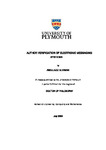AUTHOR VERIFICATION OF ELECTRONIC MESSAGING SYSTEMS
| dc.contributor.supervisor | Clarke, Nathan | |
| dc.contributor.author | ALTAMIMI, ABDULAZIZ | |
| dc.contributor.other | School of Engineering, Computing and Mathematics | en_US |
| dc.date.accessioned | 2020-09-18T15:37:51Z | |
| dc.date.issued | 2020 | |
| dc.date.issued | 2020 | |
| dc.identifier | 10229916 | en_US |
| dc.identifier.uri | http://hdl.handle.net/10026.1/16396 | |
| dc.description.abstract |
Messaging systems have become a hugely popular new paradigm for sending and delivering text messages; however, online messaging platforms have also become an ideal place for criminals due to their anonymity, ease of use and low cost. Therefore, the ability to verify the identity of individuals involved in criminal activity is becoming increasingly important. The majority of research in this area has focused on traditional authorship problems that deal with single-domain datasets and large bodies of text. Few research studies have sought to explore multi-platform author verification as a possible solution to problems around forensics and security. Therefore, this research has investigated the ability to identify individuals on messaging systems, and has applied this to the modern messaging platforms of Email, Twitter, Facebook and Text messages, using different single-domain datasets for population-based and user-based verification approaches. Through a novel technique of cross-domain research using real scenarios, the domain incompatibilities of profiles from different distributions has been assessed, based on real-life corpora using data from 50 authors who use each of the aforementioned domains. The results show that the use of linguistics is likely be similar between platforms, on average, for a population-based approach. The best corpus experimental result achieved a low EER of 7.97% for Text messages, showing the usefulness of single-domain platforms where the use of linguistics is likely be similar, such as Text messages and Emails. For the user-based approach, there is very little evidence of a strong correlation of stylometry between platforms. It has been shown that linguistic features on some individual platforms have features in common with other platforms, and lexical features play a crucial role in the similarities between users’ modern platforms. Therefore, this research shows that the ability to identify individuals on messaging platforms may provide a viable solution to problems around forensics and security, and help against a range of criminal activities, such as sending spam texts, grooming children, and encouraging violence and terrorism. | en_US |
| dc.description.sponsorship | Royal Embassy of Saudi Arabia, London | en_US |
| dc.language.iso | en | |
| dc.publisher | University of Plymouth | |
| dc.rights | Attribution-NoDerivs 3.0 United States | * |
| dc.rights.uri | http://creativecommons.org/licenses/by-nd/3.0/us/ | * |
| dc.subject | Verification | |
| dc.subject | Biometric | |
| dc.subject | Messaging systems | |
| dc.subject | Authorship | en_US |
| dc.subject.classification | PhD | en_US |
| dc.title | AUTHOR VERIFICATION OF ELECTRONIC MESSAGING SYSTEMS | en_US |
| dc.type | Thesis | |
| plymouth.version | publishable | en_US |
| dc.identifier.doi | http://dx.doi.org/10.24382/396 | |
| dc.rights.embargodate | 2021-09-18T15:37:51Z | |
| dc.rights.embargoperiod | 12 months | en_US |
| dc.type.qualification | Doctorate | en_US |
| rioxxterms.version | NA |
Files in this item
This item appears in the following Collection(s)
-
01 Research Theses Main Collection
Research Theses Main



